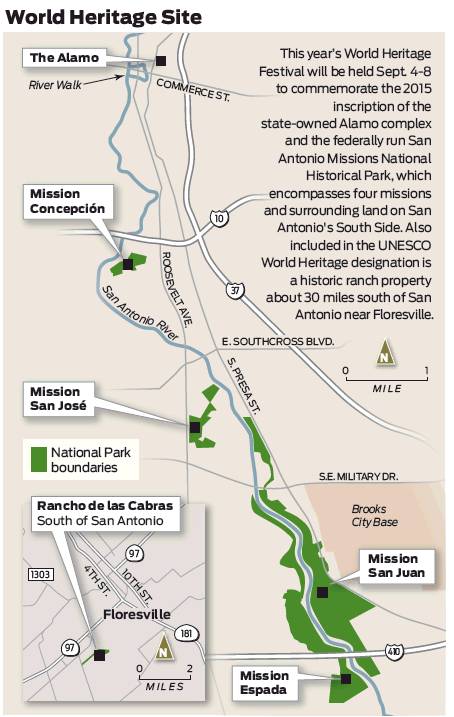MISSIONS ARE IN THE SPOTLIGHT ONCE MORE
Festival marks status as world landmarks
By Scott Huddleston STAFF WRITER
The fourth annual World Heritage Festival got off to a divine start Wednesday morning with a blessing ceremony by the Tehuan Band of Mission Indians of San Antonio, and officials emphasizing the value of the city’s historic missions that date back nearly 300 years.
“This was not built out of people volunteering to do this,” City Councilwoman Rebecca Viagran said, gesturing toward Mission Concepción — the nation’s oldest unrestored stone church. “This was hard. But through it, what we do is we find our identity together.”
The festival is a series of events designed to boost appreciation among visitors and locals alike of the internationally recognized Spanish colonial buildings, ruins and farmlands.
Viagran and a host of other officials gathered at Mission Concepción to kick off the five-day festival, which will include the release of a commemorative quarter, an outdoor movie screening, a mariachi Mass and a riverside procession, among other events.
“I hope you can get on the river, ride your bike, walk or just celebrate and talk to one another … about what the missions mean to you,” Viagran said.
Four years have passed since the state-owned Alamo, site of Mission San Antonio de Valero, and the four missions that comprise the federally run San Antonio Missions National Historical Park, were inscribed as the only UNESCO World Heritage Site in Texas.
That acknowledgment by an international panel in Bonn, Germany, of the missions’ “outstanding universal value” placed them on the same level of global prominence as the Taj Mahal, Eiffel Tower and Grand Canyon, Viagran said.
The five missionary-led Native American communities that formed along the San Antonio River brought about a radical change in the way of life in Texas, and established an initial foothold for what now is America’s seventh-largest city.
At the conclusion of a nine-year nomination process, the missions, as well as Rancho de las Cabras near Floresville, were recognized as “an exceptionally complete example of the Spanish crown’s efforts to colonize, evangelize and defend the northern frontier of New Spain,” as stated in the application.
The annual festival gives San Antonians a chance to revisit the missions, as well as the 8-mile Mission Reach of the river — “the largest ecological restoration of an urban river in the United States,” Bexar County Judge Nelson Wolff said.
“When the missions first came, they became the focal point of integrating two great societies,” Wolff added — the indigenous Native Americans and the Spaniards.
In addition to daily events that are free and open to the public, volunteers, contractors and students will repair and spruce up to 20 houses near Mission Concepción during a one-day service “Rehabarama” event Saturday, coordinated by the city’s Office of Historic Preservation.
Since the designation, the city has created a World Heritage Office that oversees Mission Marquee Plaza and the Spanish Governor’s Palace, as well as activities under a 2017 UNESCO designation as a Creative City of Gastronomy, celebrating the local cultural heritage of food.
The office also has been tasked with crafting and implementing a World Heritage Work Plan that encompasses land use and zoning around the missions and adjacent buffer zones, along with infrastructure, transportation, beautification, economic development, marketing and outreach.
The office, with five full-time staff members, also is helping implement $37 million in street, drainage, way-finding, signage, a World Heritage visitor center and other improvements from the 2017 bond issue, and shepherding a public-input vision process for a 6-mile stretch of Roosevelt Avenue.
“We’ll have a bond in 2022, and we need to plan for the future,” said Colleen Swain, director of the World Heritage Office.
The city also has developed height restrictions to protect views around the missions, developed a “legacy business” program to help longtime commercial interests in the area and adopted building design standards for the Roosevelt and Presa Street corridors.
Swain’s office also is working with the San Antonio River Authority, Visit San Antonio and Bexar County on a visitor survey at the four federal missions, to be finished by the end of year.
“That will help us plan for the future as well,” she said. shuddleston@express-news .net


